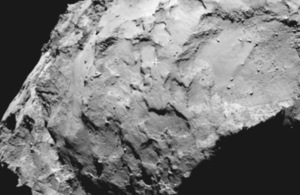Site ‘J’ marks the spot for Rosetta’s lander
Rosetta’s lander will target a site that offers unique scientific potential, hints of activity nearby, and minimum risk.

Philae’s primary landing site. Credit: ESA/Rosetta/MPS for OSIRIS Team MPS/UPD/LAM/IAA/SSO/INTA/UPM/DASP/IDA.
Rosetta’s lander Philae will target Site J, an intriguing region on Comet 67P/Churyumov–Gerasimenko that offers unique scientific potential, with hints of activity nearby, and minimum risk to the lander compared to the other candidate sites.
The landing site selection is a major milestone for the UK-led Ptolemy instrument team which is poised to begin investigating the comet’s surface and subsurface.
Ian Wright, Professor of Planetary Sciences at the Open University and Principal Investigator for the Ptolemy instrument, said:
The Ptolemy instrument team can’t wait to get down on the surface and start making measurements on the body itself. We will be looking for evidence recorded in remnants of debris that survived the processes of planet formation. This is not merely a period of pre-history, but one that pre-dates the origin of life itself.
Site J is on the ‘head’ of the comet, an irregular shaped world that is just over 4 km across at its widest point. The decision to select Site J as the primary site was unanimous. The backup, Site C, is located on the ‘body’ of the comet.

Philae’s primary landing site in context. Credit: ESA/Rosetta/MPS for OSIRIS Team MPS/UPD/LAM/IAA/SSO/INTA/UPM/DASP/IDA.
The 100 kg lander is planned to reach the surface on 11 November, where it will perform in-depth measurements to characterise the nucleus in situ, in a totally unprecedented way.
The race to find the landing site could only begin once Rosetta arrived at the comet on 6 August, when the comet was seen close-up for the first time. By 24 August, using data collected when Rosetta was still about 100 km from the comet five candidate regions had been identified for further analysis.
Since then, the spacecraft has moved to within 30 km of the comet, affording more detailed scientific measurements of the candidate sites. In parallel, the operations and flight dynamics teams have been exploring options for delivering the lander to all five candidate landing sites.
Over the weekend, the Landing Site Selection Group of engineers and scientists from Philae’s Science, Operations and Navigation Centre at France’s CNES space agency, the Lander Control Centre at DLR, scientists representing the Philae Lander instruments and ESA’s Rosetta team met at CNES, Toulouse, France, to consider the available data and to choose the primary and backup sites.
A number of critical aspects had to be considered, not least that it had to be possible to identify a safe trajectory for deploying Philae to the surface and that the density of visible hazards in the landing zone should be minimal. Once on the surface, other factors come into play, including the balance of daylight and night-time hours, and the frequency of communications passes with the orbiter.
The descent to the comet is passive and it is only possible to predict that the landing point will place within a ‘landing ellipse’ typically a few hundred metres in size.
A one square kilometre area was assessed for each candidate site. At Site J, the majority of slopes are less than 30º relative to the local vertical, reducing the chances of Philae toppling over during touchdown. Site J also appears to have relatively few boulders, and receives sufficient daily illumination to recharge Philae and continue science operations on the surface beyond the initial battery-powered phase.
Provisional assessment of the trajectory to Site J found that the descent time of Philae to the surface would be about seven hours, a length that does not compromise the on-comet observations by using up too much of the battery during the descent.
Both Sites B and C were considered as the backup, but C was preferred because of a higher illumination profile and fewer boulders.
A detailed operational timeline will now be prepared to determine the precise approach trajectory of Rosetta in order to deliver Philae to Site J. The landing must take place before mid-November, as the comet is predicted to grow more active as it moves closer to the Sun.
Once deployed from Rosetta, Philae’s descent will be autonomous, with commands having been prepared by the Lander Control Centre at DLR, and uploaded via Rosetta mission control before separation.
During the descent, images will be taken and other observations of the comet’s environment will be made.
Once the lander touches down, at the equivalent of walking pace, it will use harpoons and ice screws to fix it onto the surface. It will then make a 360° panoramic image of the landing site to help determine where and in what orientation it has landed.
The initial science phase will then begin, with instruments analysing the plasma and magnetic environment, and the surface and subsurface temperature. The lander will also drill and collect samples from beneath the surface, delivering them to the on-board laboratory for analysis. The interior structure of the comet will also be explored by sending radio waves through the surface towards Rosetta.
No one has ever attempted to land on a comet before, so it is a real challenge
says Fred Jansen, ESA Rosetta mission manager.
The complicated ‘double’ structure of the comet has had a considerable impact on the overall risks related to landing, but they are risks worth taking to have the chance of making the first ever soft landing on a comet.
The landing date should be confirmed on 26 September after further trajectory analysis and the final Go/No Go for a landing at the primary site will follow a comprehensive readiness review on 14 October.